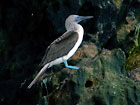

 | |||||||||||||||||
|
|
Journals 2007/2008Beth Jewell
January 17, 2008 The daily routine is fairly constant. The divers start getting ready for their first dive around 6:30, come up and breakfast is waiting on them. After their second dive lunch was waiting on them. Other than the first day, we spend a good deal of the afternoon cruising to the next dive site. Depending on the length of time it takes us to reach our next site, the divers make one to two more dives before dinner. It really is a full day for them. While they are diving I work on the time-lapse pictures, identifying the fish in each frame to determine diversity. Considering the camera is set to take photos every minute and they are left down for hours, I have more than enough to keep me busy. It is hard to see the computer screen with the glare of the sun so I use a towel over my head to block out the glare. I have most of the fish down by now, but keep a fish guide handy just in case.
Occasionally I join them on the panga just to get a closer view of the cliffs. Today while out on the panga waiting for the divers to complete their dive, the panga driver took me for a quick spin around the island. He stopped to let me watch the sea lions bask in the sun and play. A couple of sea lions seemed to be a bit curious about us, coming over for a look as they played in the surf. I watched a sea lion lay on the cliff about 3 meters up from the water line perfectly still for at least 30 minutes. He was so still at first that I wasn't sure if it was a sea lion or an indentation in the cliff. Barnacles and Sally Lightfoot crabs were all along the water line on the shaded side of the island. The crabs could be seen 3-4 meters up the cliff. Further up the cliffs blue-footed boobies and lava gulls rested on the ledges. Going yet further up the cliffs, pockets of soil could be seen with the occasional cactus poking out.
Meals on board have all been very good, with fresh fish, chicken, fruit, and rice being the main ingredients. The cook makes a different juice for every meal by pureeing fruit and adding some water. I have no idea what I am drinking most times but it has all been very good. Today I watched as the captain filleted our lunch. He had two large snappers that he cut first down one length of the body and then the other side. The skin and backbone went overboard and flocks of pelicans and cormorants soon became our best friends. The Mabel is a small rugged vessel. We have enough room to be constantly tripping over one another. I have a coined a new definition of "being in the way." It is wherever I am standing or sitting. My cabin has two bunks and nothing else. I use the top bunk for my belongings and am careful not to bump my head when turning over in the bottom bunk. There are two heads down in my "wing" of cabins. You flush the toilet with the use of a pump. The shower is a nozzle that hangs over the door. Nothing but cold showers on this cruise! Our cook prepares meals in a space that he can barely turn around in. He can reach the sink and propane stove without moving his feet. Food is stashed under the seats in the dining area, in compartments on the stern, and in a chest style refrigerator. All the fresh water we will be using on the cruise is stored on the bow in 5 gallon containers. We eat, process data, socialize and take naps around a large table on the main deck. Last night two more divers, Maggy and Angel Brandt, joined us. Maggy is working with Jon on her PhD studying sea urchin diversity on primary productivity. She met Jon a few years ago in the Galápagos as she was finishing her undergraduate thesis. After working for him for 2 years as a technician, she decided to work on her PhD. Her research focuses on three species of sea urchins and she wants to determine which species has the greatest grazing effect by testing whether they graze more as a single species or a combination of species. Once she determines the most important grazers, she will then begin to determine what feeding mechanisms such as mouth size or the ability to hold on to rocks, makes them more successful. She arrived in the Galápagos in November to culture algae on acetate plates. These plates are later put in cages with either one species of algae, two different species of algae, or three species of algae. Maggy takes pictures of the plates before and then after a month. Measuring the chlorophyll concentration on the plates provides her with answers as to how the diversity of sea urchins impacts their grazing rates.
We had another long cruise to the next dive site. Most of the divers are either napping or reading. It is a good time to catch up on sleep and enter data into the computer. I have been watching the blue-footed boobies dive into the water. They fly high above the water and then dive like a missile into the water. I was talking to Angel earlier and he was telling me they are not the smartest of birds and are scary when one is diving. He guessed that they can dive 3-4 meters into the water. I guess having a sharp beak coming at you while under the water could make for an anxious moment.
Jon Witman's dive notes for the day: |
||||||||||||||||



